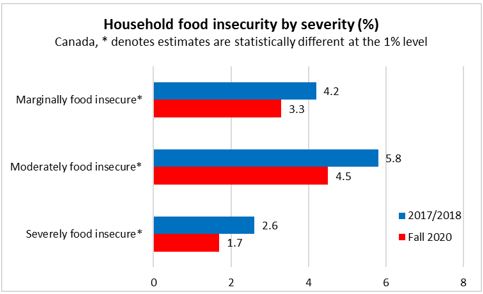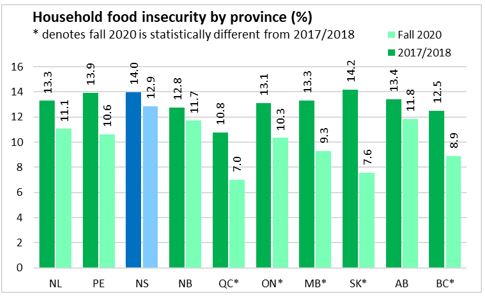The Economics and Statistics Division maintains archives of previous publications for accountability purposes, but makes no updates to keep these documents current with the latest data revisions from Statistics Canada. As a result, information in older documents may not be accurate. Please exercise caution when referring to older documents. For the latest information and historical data, please contact the individual listed to the right.
<--- Return to Archive
For additional information relating to this article, please contact:
February 16, 2022HOUSEHOLD FOOD INSECURITY IN CANADA EARLY IN THE COVID-19 PANDEMIC Today, Statistics Canada released the study “Household food insecurity in Canada early in the COVID-19 pandemic” to examine if the pandemic exacerbated food insecurity. The study compares pre-pandemic levels of food insecurity to levels six to nine months into the pandemic at the national and provincial level, as well as by sociodemographic characteristics of the household.
Data were collected from September to December 2020 from the Canadian Community Health Survey (CCHS) during the second wave of the pandemic in Canada. The CCHS is a cross-sectional survey of the population aged 12 and older, excluding people living on reserves or other Indigenous settlements, full-time members of the Canadian Armed Forces, youth aged 12 to 17 living in foster homes, the institutionalized population, and residents of certain remote regions. Together, these exclusions represent less than 3% of the Canadian population aged 12 and older.
The Household Food Security Survey Module was used to categorize respondents’ household food security status within the previous 12 months as food secure or marginally, moderately or severely insecure. These four situations are defined as:
- Food secure: no indication of difficulty with income related food access.
- Marginally food insecure: exactly one indication of difficulty with income-related food access, such as worry about running out of food or limited food selection.
- Moderately food insecure: indication of compromise in quality and/or quantity of food consumed.
- Severely food insecure: indication of reduced food intake and disrupted eating patterns.
Results were compared with results from the 2017/2018 CCHS to determine if pandemic-era outcomes were statistically different from the pre-pandemic period.
In 2017/2018, 12.6% of Canadians had experienced some level of food insecurity in the previous 12 months. During the second wave of the COVID-19 pandemic, this rate had fallen to 9.6%. This was a statistically significant decline in the rate of food insecurity across the three categories of food insecurity.

All provinces reported lower rates of food insecurity in the fall of 2020, with statistically significant declines in Quebec, Ontario, Manitoba, Saskatchewan and British Columbia compared to 2017/2018.

In 2017/2018, higher levels of household food insecurity were more likely among those who were younger, those with less than a high school education, those living in lone-parent-led households, those living in households reliant on social assistance or employment insurance as their primary source of income, those who rented rather than owned their dwelling and who identify as Indigenous or Black. In fall 2020, there were statistically significant declines in food insecurity among several of these groups, including people with Indigenous identity, households with children, lone-parent households, renters, and those with lower education levels. There was no statistically significant decline in the household food security status for those who identified as visible minorities; immigrants to Canada; and individuals in households whose main source of income in 2019 was social assistance, employment insurance, or other or none.
The study also looked at food insecurity by working status for Canadians aged 15 to 75. Compared to the pre-pandemic period (2017/2018), the rate of food insecurity was significantly lower for both those with jobs and without jobs in fall 2020. The prevalence of food insecurity was statistically lower in fall 2020 among those working in retail trade, accommodation and food services, and other (personal and repair) services.
The fall 2020 survey included a question on working from home that was not in previous surveys. In fall 2020, Canadians who reported working from home during the previous week reported lower rates of food insecurity (5.3%) than those who worked outside the home (9.5%).
The authors note that food insecurity is tightly linked to material and financial hardship. At the time of this survey, there were significant financial supports in place from the federal government to alleviate the financial impact of the COVID-19 pandemic. The results of this study are consistent with emerging reports which suggest that the pandemic relief benefits mitigated the impact of job and income losses, especially for middle and low-income households. The reduction in overall household spending and increased disposable income during this time may have also buffered against food insecurity during this period.
Source: Statistics Canada, Household food insecurity in Canada early in the COVID-19 pandemic
<--- Return to Archive